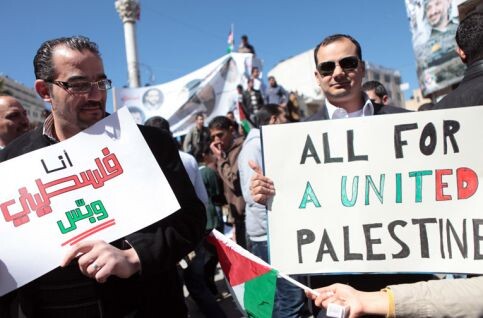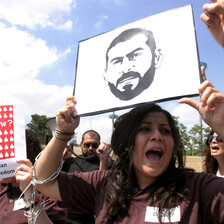The Electronic Intifada 24 March 2011

Hundreds gather in Ramallah’s city center to call for national unity, 15 March 2011. (Oren Ziz/ActiveStills)
Twitter was ablaze, Facebook groups sprouted like mushrooms and bloggers typed on overdrive, both from within the occupied Palestinian territories and abroad. These were the weeks and days leading up to the popular demonstrations of 15 March, organized by a coalition of Palestinian youth groups across the Gaza Strip and the West Bank, inspired by Arab popular uprisings and infected by the highly contagious freedom/revolution bug sweeping the region.
The goal: a mass mobilization of Palestinians to pressure the Hamas-run government in Gaza, and the Fatah-led Palestinian Authority in the West Bank, to end the four-year-long division. But rather than topple the governments, as was the goal with the uprisings in neighboring countries, demonstrators hope to be able to bring them together. Increasingly belligerent Israeli measures, mainly the continued siege on Gaza and settlement expansion in the West Bank, have fueled Palestinians’ discontent with their leaderships. People fear that the divide will further weaken the Palestinian front, leaving it even more vulnerable in the face of Israel’s aggressive policies.
The day arrived. In the West Bank city of Ramallah crowds gathered in al-Manara Square, chanting against the division. Elsewhere in the West Bank, in Nabus, Hebron and Bethlehem, hundreds took to the streets in peaceful pro-unity marches; in East Jerusalem the Israeli military was on high alert as demonstrators gathered outside the Old City’s Damascus Gate, raising Palestinian flags and calling for unity.
Gaza too was fully on board. Had you stopped any person on the street a few days before and asked them about the most likely 15 March scenario, their answer would have been as follows:
People will begin to gather in small groups in the morning, they will all be carrying Palestinian flags and repeating slogans calling for unity between the rival factions Fatah and Hamas. There will be banners and flyers, kuffiyehs (the traditional checkered scarf) and headbands emblazoned with the colors of the Palestinian flag; there will be megaphones and patriotic songs, but there will be no sign of sectarianism or factional representation.
Things will be calm until the groups of demonstrators reach the Square of the Unknown Soldier in the heart of Gaza City. If a substantial amount of protesters (more than a hundred) decide to remain for more than an hour or so, Hamas supporters, waiting on the sidelines, will begin to infiltrate the crowd and grow in number, you will begin to see green flags and green headbands and megaphones blaring Qassam-glorifying songs will drown out the national anthem and other non-Hamas tunes. Police presence will intensify and tensions will rise when the demonstrators (inevitably) clash with Hamas affiliates and members of the Hamas police force, who they feel are hijacking their demonstration. The “independent” demonstrators will attempt to move to a new location (they were indeed led by the organizers to al-Katiba square by al-Azhar University, a Fatah stronghold), and will be followed and closely monitored by the police and eventually force will be employed to disperse them.
And so the events unfolded, precisely as the hypothetical speculator would have predicted. Follow-up demonstrations occurred in the following days, smaller in size and damper in enthusiasm, and so 15 March passed, leaving behind no more than a faint twitch amid the racking convulsions of suppression and affliction.
Does it come as a surprise? Clearly Palestinians in both Gaza and the West Bank were prepared for a security crackdown or there would have been no need to build up so much momentum for an event supporting an end to intra-Palestinian division. And clearly escalation was sought: it is the only way both leaderships will be made to feel the pressure to resolve their differences.
Naturally, both Hamas in Gaza and Fatah in the West Bank claimed unwavering support of the pro-unity demonstrations and heartfelt commitment to unifying the Palestinian front and reestablishing democracy. Assuming this were the case, it is curious that any initiatives towards either goal, by either government, have only been taken on the heels of unsettling events, and died down almost as fast as they were instigated.
For instance, senior Fatah official Nabil Shaath’s three-day visit to Gaza in February of last year was welcomed by Prime Minister Ismail Haniyeh in Gaza, and Shaath was the first-high ranking Palestinian Authority official to visit from Ramallah since the division began in June 2007. The visit made for a good photo-op and was intertwined with memorable speeches, phony optimism and uncomfortable (phony) smiles. It was a feeble attempt by both leaderships to pacify feelings of unrest that had risen among Palestinians (especially after the PA stonewalled the Goldstone report vote at the UN, and the subsequent refusal of Hamas to sign a reconciliation agreement). Any attempts on the public’s part to determine any further effects and repercussions of this visit failed.
During the 13 months that followed, both the PA and Gaza governments have done their best to crack down on members of the rival party in their respective territories. The Hamas government claims that PA security forces arrested 3,000 Hamas loyalists in the West Bank in 2010, while Hamas was accused by Fatah of arresting 3,120 of its supporters in Gaza that same year.
Illegal detention and in many cases, torture and sometimes death, followed. Condemnations were batted back and forth like a tennis ball. Hamas accuses Fatah of complicity with Israel in the Dubai assassination of its operative Mahmoud al-Mabhouh, Fatah accuses Hamas of the attempted assassination of one of its officials in Nablus, and amid all this, “reconciliation efforts” continued. Discussions were held between a Fatah delegation headed by Azzam al-Ahmed and a Hamas delegation headed by Mousa Abu Marzouk on the Egyptian reconciliation paper in Damascus in September 2010. Of course, both sides left feeling “positive.” They left as close to reconciliation as they’d ever been.
The Fatah-led PA has a long, open and well-documented record of working with Israel under the internationally-endorsed framework of “security cooperation,” also a major cause of the division. Hamas is not willing to accept such cooperation which it sees as targeted against all forms of resistance, and Fatah leaders are not willing or able to give it up.
In January 2011, Al Jazeera released the Palestine Papers revealing the extent of PA concessions of Palestinian rights, and walls didn’t really come crashing down in the immediate sense (except for the resignation of PLO chief negotiator Saeb Erekat, who has been in place since the Oslo accords were signed), as the scandal was somewhat overshadowed by the Tunisian and Egyptian uprisings. But both the leaked papers and the uprisings managed to convince Mahmoud Abbas that running for another term was a bad idea, and of course, that a reconciliation overture was due, hence Abbas’ announcement that he would visit Gaza, to reach an agreement no less.
Amid these proceedings Gaza, appeared like a ticking time bomb, but just when it reached an incendiary point, it would crackle and spit, and eventually fizzle out.
This is largely due to the dissatisfaction among people in Gaza with the growing isolation and difficult conditions under Hamas, and at the same time their unwillingness to direct their fight towards an iron-handed, but otherwise commendable government.
Furthermore, although focal, Hamas’ security apparatus and tight governance do not represent the full extent of Hamas’ hold on the Gaza Strip. The movement is entrenched in the very fabric of Gaza’s socio-economic and civilian infrastructure. Hamas as a government and as a political movement has built housing projects, vocational education centers, clinics, acquired prime real estate, runs charities and nongovernmental organizations, employs tens if not hundreds of thousands of workers, both in government offices and private enterprises, owns banks, factories, insurance companies and enjoys a wide base of supporters and sympathizers.
If recent lessons from the Arab world had not taught us otherwise, one would almost believe in the near impossibility of marginalizing Gaza’s ruling party. But to borrow a phrase from other deposed rulers, Gaza is not Egypt or Tunisia.
Fragmenting Palestinian efforts and redirecting the course of the struggle away from a focus on the occupation and siege, and toward internal parties will provide Israel with the best cover for continued settlement expansion, land annexation, demolition, expulsion, land razing and killing among a multitude of other violations.
At the risk of sounding like a proponent of factionalism, I cannot but mention that many of those demonstrating in Gaza on 15 March came from Fatah backgrounds or were affiliated with the disaffected Fatah movement. This is by no means sanctioning their suppression and harassment by security forces and the intelligence apparatus, but it merely goes to show how deeply-rooted partisanship is within the masses, differing political agendas and approaches towards the conflict polarizing the population and widening the rift to unprecedented degrees. And I will venture to say that those demonstrators were out there protesting against Hamas as much as they were protesting against division. Again, it is their indisputable right to do so but the deep animosity between both factions illustrates why Hamas movement security officials felt threatened, even by a peaceful assembly.
Divided, Palestinians will surely fall and fueling the internal fire will only serve to deepen the divide. If Palestinians truly desire unity their focus should be turned within. The public needs to free itself of blind and radical factionalism as much, if not more than the leaderships, and only then will demonstrations such as 15 March be effective.
Despite differing ideologies, all Palestinian factions, whether Islamic, socialist or secular, were born from the collective struggle to liberate an occupied land. Returning to the roots of the struggle will bring down the barriers formed by self-interest and a blind desire for power, of which rival parties in Gaza and Ramallah are both guilty.
Safa Joudeh is a freelance broadcast journalist and writer from the Gaza Strip, reporting from Gaza and Egypt. Follow her on Twitter (@SafaJoudeh).




